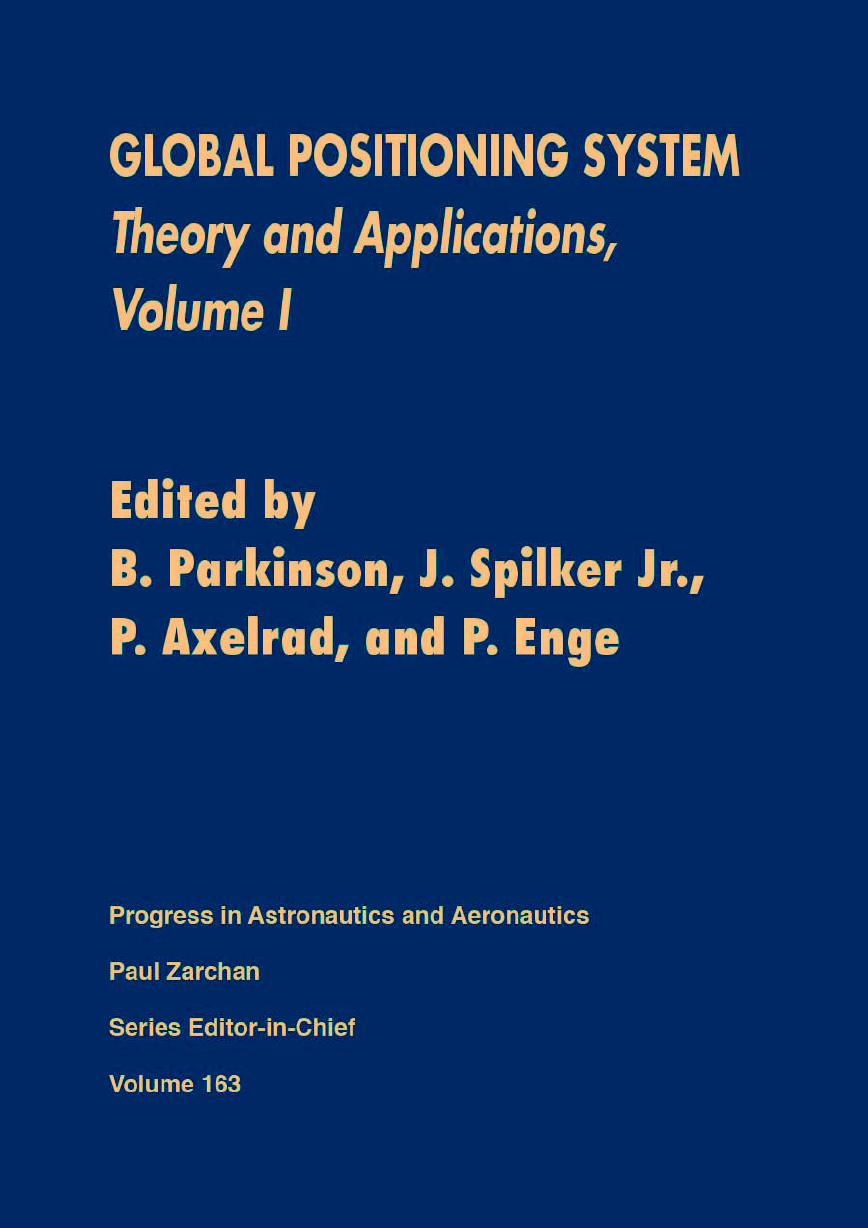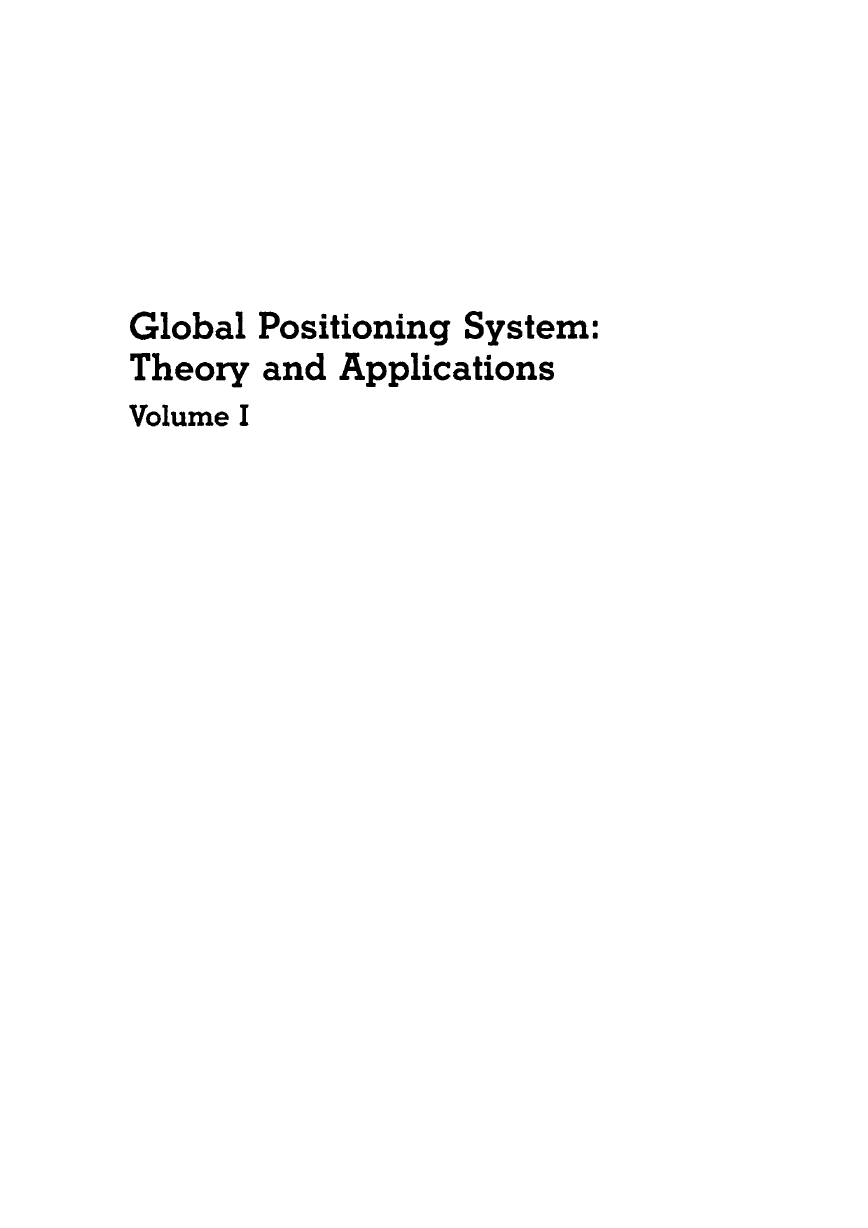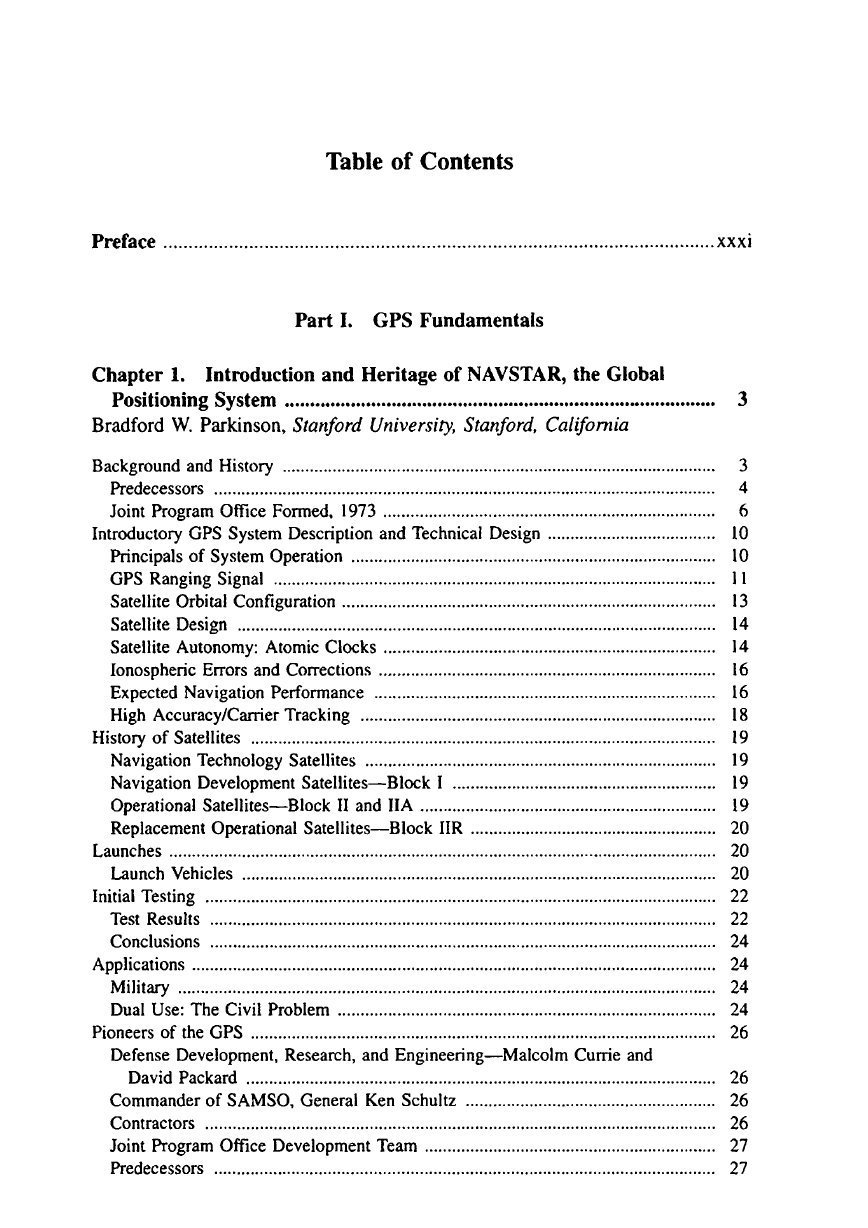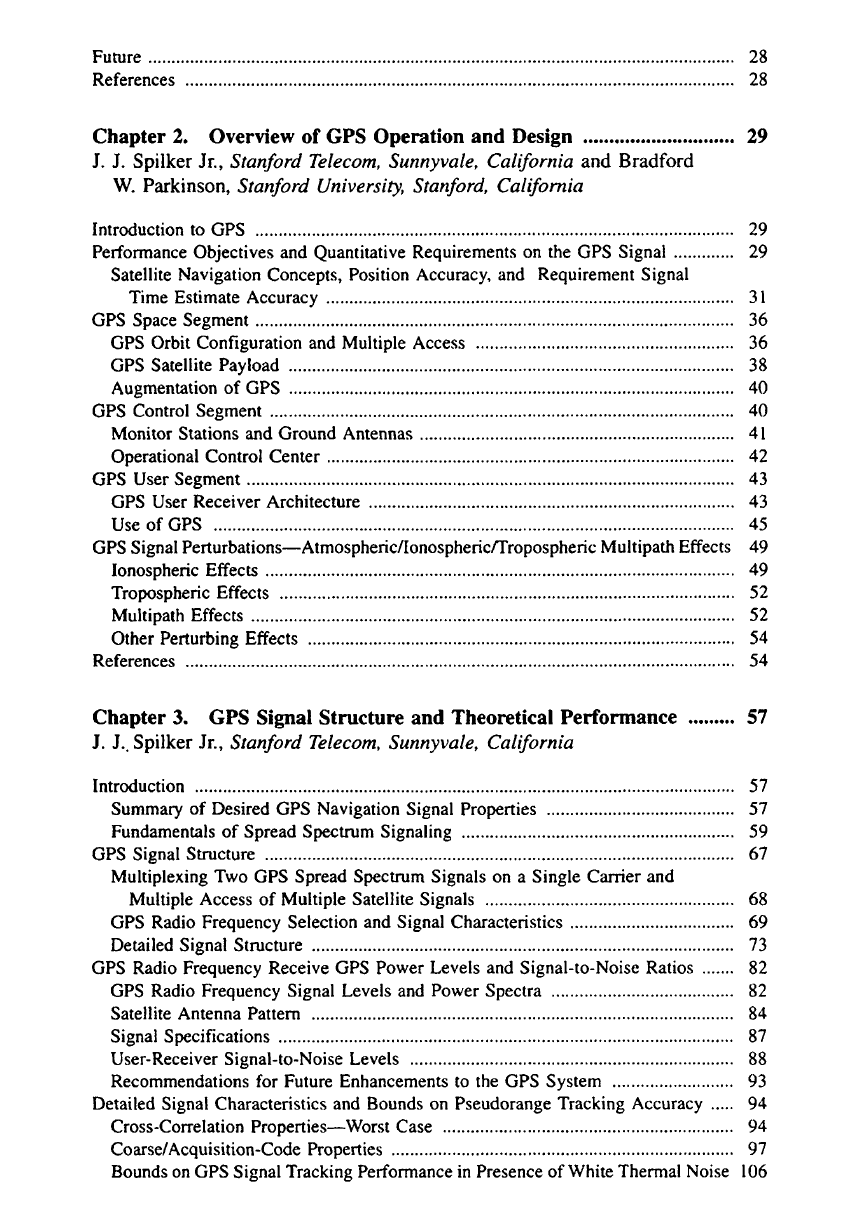Table of Contents�
Preface�
Part I. GPS Fundamentals�
Chapter 1. Introduction and Heritage of NAVSTAR, the Global Positioning System�
Background and History�
Predecessors�
Joint Program Office Formed, 1973�
Introductory GPS System Description and Technical Design�
Principals of System Operation�
GPS Ranging Signal�
Satellite Orbital Configuration�
Satellite Design�
Satellite Autonomy: Atomic Clocks�
Ionospheric Errors and Corrections�
Expected Navigation Performance�
High Accuracy/Carrier Tracking�
History of Satellites�
Navigation Technology Satellites�
Navigation Development Satellites-Block I�
Operational Satellites-Block II and IIA�
Replacement Operational Satellites-Block IIR�
Launches�
Launch Vehicles�
Initial Testing�
Test Results�
Conclusions�
Applications�
Military�
Dual Use: The Civil Problem�
Pioneers of the GPS�
Defense Development, Research, and Engineering-Malcolm Currie and David Packard�
Commander of SAMSO, General Ken Schultz�
Contractors�
Joint Program Office Development Team�
Predecessors�
Future�
References�
Chapter 2. Overview of GPS Operation and Design�
Introduction to GPS�
Performance Objectives and Quantitative Requirements on the GPS Signal�
Satellite Navigation Concepts, Position Accuracy, and Requirement Signal Time Estimate Accuracy�
GPS Space Segment�
GPS Orbit Configuration and Multiple Access�
GPS Satellite Payload�
Augmentation of GPS�
GPS Control Segment�
Monitor Stations and Ground Antennas�
Operational Control Center�
GPS User Segment�
GPS User Receiver Architecture�
Use of GPS�
GPS Signal Perturbations – Atmospheric/Ionospheric/Tropospheric Multipath Effects�
Ionospheric Effects�
Tropospheric Effects�
Multipath Effects�
Other Perturbing Effects�
References�
Chapter 3. GPS Signal Structure and Theoretical Performance�
Introduction�
Summary of Desired GPS Navigation Signal Properties�
Fundamentals of Spread Spectrum Signaling�
GPS Signal Structure�
Multiplexing Two GPS Spread Spectrum Signals on a Single Carrier and Multiple Access of Multiple Satellite Signals�
GPS Radio Frequency Selection and Signal Characteristics�
Detailed Signal Structure�
GPS Radio Frequency Receive GPS Power Levels and Signal-to-Noise Ratios�
GPS Radio Frequency Signal Levels and Power Spectra�
Satellite Antenna Pattern�
Signal Specifications�
User-Receiver Signal-lo-Noise Levels�
Recommendations for Future Enhancements to the GPS System�
Detailed Signal Characteristics and Bounds on Pseudorange Tracking Accuracy�
Cross-Correlation Properties-Worst Case�
Coarse/Acquisition-Code Properties�
Bounds on GPS Signal Tracking Performance in Presence of White Thermal Noise�
Appendix: Fundamental Properties of Maximal Length Shift Registers and Gold Codes�
References�
Chapter 4. GPS Navigation Data�
Introduction�
Overall Message Content of the Navigation Data�
Navigation Data Subframe. Frame. and Superframe�
Detailed Description of the Navigation Data Subframe�
Subframe 1-GPS Clock Correction and Space Vehicle Accuracy�
GPS Ephemeris Parameters-Subframes 2 and 3�
Subframes 4 and 5-Almanac, Space Vehicle Health, and Ionosphere Models�
Time, Satellite Clocks, and Clock Errors�
Mean Solar, Universal Mean Sidereal, and GPS Time�
Clock Accuracy and Clock Measurement Statistics�
Satellite Orbit and Position�
Coordinate Systems and Classical Orbital Elements�
Classical Keplerian Orbits�
Perturbation of Satellite Orbit�
Ionospheric Correction Using Measured Data�
Dual-Frequency Ionospheric Correction�
Appendix�
References�
Chapter 5. Satellite Constellation and Geometric Dilution of Precision
Introduction�
GPS Orbit Configuration, GPS-24�
GPS Orbit-Semi-Major Axis�
GPS Orbit-Satellite Phasing�
GPS Satellite Visibility and Doppler Shift�
Bound on Level of Coverage for 24 Satellites�
GPS Satellite Visibility Angle and Droopier Shift�
GPS-24 Satellite Visibility�
Augmentation of the GPS-24 Constellation�
Constellation of 30 GPS Satellites�
Coverage Swath for an Equatorial Plane of Satellites�
Satellite Ground Traces�
Geometric Dilution of Precision Performance Bounds and GPS-24 Performance�
Bounds on Geometric Dilution of Precision-Two Dimensions�
Bounds on Geometric Dilution of Precision-Three Dimensions�
Position Dilution of Precision with an Accurate Clock�
Position Dilution of Precision for the GPS-24 Constellation�
References�
Bibliography�
Chapter 6. GPS Satellite and Payload�
Spacecraft and Navigation Payload Heritage�
Concept�
Relation to Earlier Non-GPS Satellites�
Overview of Payload Evolution�
On-Orbit Performance History�
Navigation Payload Requirements�
GPS System�
GPS Performance�
GPS Signal Structure�
Payload Requirements�
Block IIR Space Vehicle Configuration�
Navigation Payload Architecture�
Block IIR Payload Design�
Payload Subsystems�
Mission Data Unit�
L-Band Subsystem�
Characteristics of the GPS L-Band Satellite Antenna�
Coverage Area�
Antenna Pattern�
Antenna Evolution�
Crosslinks�
Primary and Secondary Functions�
Autonomous Navigation�
Future Performance Improvements�
Additional Capabilities�
References�
Chapter 7. Fundamentals of Signal Tracking Theory�
Introduction�
GPS User Equipment�
GPS User Equipment-System Architecture�
Alternate Forms of Generalized Position Estimators�
Maximum Likelihood Estimates of Delay and Position�
Overall Perspective on GPS Receiver Noise Performance�
Interaction of Signal Tracking and Navigation Data Demodulation�
Delay Lock Loop Receivers for GPS Signal Tracking�
Coherent Delay Lock Tracking of Bandlimited Pseudonoise Sequences�
Noncoherent Delay Lock Loop Tracking of Pseudonoise Signals�
Quasicoherent Delay Lock Loop�
Coherent Code/Carrier Delay Lock Loop�
Carrier-Aided Pseudorange Tracking�
Vector Delay Lock Loop Processing of GPS Signals�
Independent Delay Lock Loop and Kalman Filter�
Vector Delay Lock Loop (VDLL)�
Quasioptimal Noncoherent Vector Delay Lock Loop�
Channel Capacity and the Vector Delay Lock Loop�
Appendix A: Maximum Likelihood Estimate of Delay and Position�
Appendix B: Least-Squares Estimation and Quasioptimal Vector Delay Lock Loops�
Appendix C: Noncoherent Delay Lock Loop Noise Performance with Arbitrary Early-Late Reference Spacing�
Appendix D: Probability of Losing Lock for the Noncoherent DLL�
Appendix E: Colored Measurement Noise in the Vector Delay Lock Loop�
References�
Chapter 8. GPS Receivers�
Generic Receiver Description�
Generic Receiver System Level Functions�
Design Requirements Summary�
Technology Evolution�
Historical Evolution of Design Implementation�
Current Day Design Implementation�
System Design Details�
Signal and Noise Representation�
Front-End Hardware�
Digital Signal Processing�
Receiver Software Signal Processing�
A Signal-Processing Model and Noise Bandwidth Concepts�
Signal Acquisition�
Automatic Gain Control�
Generic Tracking Loops�
Delay Lock Loops�
Carrier Tracking�
Lock Detectors�
Bit Synchronization�
Delta Demodulation, Frame Synchronization, and Parity Decoding�
Appendix A: Determination of Signal-to-Noise Density�
Appendix B: Acquisition Threshold and Performance Determination�
References�
Chapter 9. GPS Navigation Algorithms�
Introduction�
Measurement Models�
Pseudorange�
Doppler�
Accumulated Delta Range�
Navigation Delta Inputs�
Single-Point Solution�
Solution Accuracy and Dilution of Precision�
Point Solution Example�
Users Process Models�
Clock Model�
Stationary User or Vehicle�
Low Dynamics�
High Dynamics�
Kalman Filter and Alternatives�
Discrete Extended Kalman Filter Formulation�
Steady-State Filter Performance�
Alternate Forms of the Kalman Filter�
Dual-Rate Filter�
Correlated Measurement Noise�
GPS Filtering Examples�
Buoy Example�
Low Dynamics�
Unmodeled Dynamics�
Correlated Measurement Errors�
Summary�
References�
Chapter 10. GPS Operational Control Segment�
Monitor Stations�
Master Control Station�
Ground Antenna�
Navigation Data Processing�
System State Estimation�
Navigation Message Generation�
Time Coordination�
Navigation Product Validation�
References ..............:�
Part II. GPS Performance and Error Effects�
Chapter 11. GPS Error Analysis�
Introduction�
Fundamental Error Equation�
Overview of Development�
Derivation of the Fundamental Error Equation�
Geometric Dilution of Precision�
Derivation of the Geometric Dilution of Precision Equation�
Power of the GDOP Concept�
Example Calculations�
Impact of Elevation Angle on GDOP�
Ranging Errors�
Six Classes of Errors�
Ephemeris Errors�
Satellite Clock Errors�
Ionosphere Errors�
Troposhere Errors�
Multipath Errors�
Receiver Errors�
Standard Error Tables�
Error Table Without S/A: Normal Operation for C/A Code�
Error Table with S/A�
Error Table for Precise Positioning Service (PPS Dual-Frequency P/Y Code)�
Summary�
References�
Chapter 12. Ionospheric Effects on GPS�
Introduction�
Characteristics of the Ionosphere�
Refractive index of the ionosphere�
Major Effects on Global Positioning Systems Caused by the Ionosphere�
Ionospheric Group Delay-Absolute Range Error�
Ionospheric Carrier Phase Advance�
Higher-Order Ionospheric Effects�
Obtaining Absolute Total Electron Content from Dual-Frequency GPS Measurements�
Ionospheric Doppler Shift/Range-Rate Errors�
Faraday Rotation�
Angular Refraction�
Distortion of Pulse Waveforms�
Amplitude Scintillation�
Ionospheric Phase Scintillation Effects�
Total Electron Content�
Dependence of Total Electron Content on Solar Flux�
Ionospheric Models�
Single-Frequency GPS Ionospheric Corrections�
Magnetic Storms Effects on Global Positioning Systems�
Differential GPS Positioning�
Appendix: Ionospheric Correction Algorithm for the Single-Frequency GPS Users�
References�
Chapter 13. lroposheric Effects on GPS�
Troposheric Effects�
Introduction�
Atmospheric Attenuation�
Rainfall Attenuation�
Troposheric Scintillation�
Tropospheric Delay�
Path Length and Delay�
Tropospheric Refraction Versus Pressure and Temperature�
Empirical Models of the Troposhere�
Saastamoinen Total Delay Model�
Hopfield Two Quartic Model�
Black and Eisner (B&E) Model�
Water Vapor Zenith Delay Model-Berman�
Davis, Chao, and Marini Mapping Functions�
Altshuler and Kalaghan Delay Model�
Ray Tracing and Simplified Models�
Lanyi Mapping Function and GPS Control Segment Estimate�
Model Comparisons�
Tropospheric Delay Errors and GPS Positioning�
References�
Chapter 14. Multipath Effects�
Introduction�
Signal and Multipath Error Models�
Pseudorandom Noise Modulated Signal Description�
Coherent Pseudorandom Noise Receiver�
Noncoherent Pseudorandom Noise Receiver�
Simulation Results�
Aggravation and Mitigation�
Antenna Considerations�
Receiver Design�
Multipath Data Collection�
Acknowledgments�
References�
Chapter 15. Foliage Attenuation for Land Mobile Users�
Introduction�
Attenuation of an Individual Tree or Forest of Trees-Stationary User�
Foliage Attenuation-Mobile User�
Probability Distribution Models for Foliage Attenuation-Mobile User�
Measured Models-Satellite Attenuation Data�
Measured Fading for Tree-Lined Roads-Mobile Users�
References�
Chapter 16. Ephemeris and Clock Navigation Message Accuracy�
Control Segment Generation of Predicted Ephemerides and Clock Corrections�
Accuracy of the Navigation Message�
Global Network GPS Analysis at the Jet Propulsion Laboratory�
Accuracy of the Precise Solution�
Comparison of Precise Orbits with Broadcast Ephemerides�
Comparison of the Precise Clocks with Broadcast Clocks�
Summary and Discussion�
Appendix: User Equivalent Range Error�
References�
Chapter 17. Selective Availability�
Goals and History�
Implementation�
Characterization of Selective Availability�
Second-Order Gauss-Markov Model�
Autoregressive Model�
Analytic Model�
Recursive Autoregressive Model (Lattice Filter)�
Selective Availability Model Summary�
References�
Chapter 18. Introduction to Relativistic Effects on the Global Positioning System�
Introduction�
Objectives�
Statement of the GPS Problem�
Introduction to the Elementary Principles of Relativity�
Euclidean Geometry and Newtonian Physics�
Space-Time Coordinates and the Lorentz Transformation�
Relativistic Effects of Rotation in the Absence of a Gravitational Field�
Principle of .Equivalence�
Relativistic Effects in GPS�
Relativistic Effects on Earth-Based Clocks�
Relativistics Effects for Users of the GPS�
Secondary Relativistic Effects�
References�
Chapter 19. Joint Program Office Test Results�
Introduction�
U.S. Army Yuma Proving Ground (YPG)�
Reasons for Selection of Yuma Proving Ground�
Lasers�
Range Space�
Joint Program Office Operating Location�
Satellite Constellation for Test Support�
Control Segment Responsiveness to Testing Needs�
Trajectory Determination YPG�
Real-Time Estimate�
Best Estimate of Trajectory�
Validation of Truth Trajectory Accuracy�
Ground Truth�
Phase I Test (1972-1979)�
Ground Transmitters�
Navy Testing for Phase 1�
Tests Between Phase I and Phase II (1979-1982)�
Weapons Delivery�
Differential Tests�
Phase II: Full-Scale Engineering Development Tests (1982-1985)�
Summary�
Bibliography�
Chapter 20. Interference Effects and Mitigation Techniques�
Introduction�
Possible Sources of Interference�
Frequency Allocation in Adjacent and Subharmonic Bands�
Receiver Design for Tolerance to Interference�
Receiver Systems�
Quantizer Effects in the Presence of Interference�
Effects of Interference on the GPS CIA Receiver�
Effects of the CIA-Code Line Components on Narrow-Band Interference Performance�
Narrow-Band Interference Effects-Spectra of Correlator Output�
Interference Effects-Effects on Receiver-Tracking Loops�
Detection of Interference, Adaptive Delay Lock Loop, Adaptive Frequency Notch Filtering, and Adaptive Null Steering Antennas�
Adaptation of the Delay Lock Loop and Vector Delay Lock Loop�
Rejection of Narrow-Band Interference by Adaptive Frequency Nulling Filters�
Adaptive Antennas for Point Source Interference�
Augmentation of the GPS Signals and Constellation�
Appendix: Mean and Variance of the Correlator Output for an M-Bit Quantizer�
References�
Author Index�
Subject Index�
















 2023年江西萍乡中考道德与法治真题及答案.doc
2023年江西萍乡中考道德与法治真题及答案.doc 2012年重庆南川中考生物真题及答案.doc
2012年重庆南川中考生物真题及答案.doc 2013年江西师范大学地理学综合及文艺理论基础考研真题.doc
2013年江西师范大学地理学综合及文艺理论基础考研真题.doc 2020年四川甘孜小升初语文真题及答案I卷.doc
2020年四川甘孜小升初语文真题及答案I卷.doc 2020年注册岩土工程师专业基础考试真题及答案.doc
2020年注册岩土工程师专业基础考试真题及答案.doc 2023-2024学年福建省厦门市九年级上学期数学月考试题及答案.doc
2023-2024学年福建省厦门市九年级上学期数学月考试题及答案.doc 2021-2022学年辽宁省沈阳市大东区九年级上学期语文期末试题及答案.doc
2021-2022学年辽宁省沈阳市大东区九年级上学期语文期末试题及答案.doc 2022-2023学年北京东城区初三第一学期物理期末试卷及答案.doc
2022-2023学年北京东城区初三第一学期物理期末试卷及答案.doc 2018上半年江西教师资格初中地理学科知识与教学能力真题及答案.doc
2018上半年江西教师资格初中地理学科知识与教学能力真题及答案.doc 2012年河北国家公务员申论考试真题及答案-省级.doc
2012年河北国家公务员申论考试真题及答案-省级.doc 2020-2021学年江苏省扬州市江都区邵樊片九年级上学期数学第一次质量检测试题及答案.doc
2020-2021学年江苏省扬州市江都区邵樊片九年级上学期数学第一次质量检测试题及答案.doc 2022下半年黑龙江教师资格证中学综合素质真题及答案.doc
2022下半年黑龙江教师资格证中学综合素质真题及答案.doc